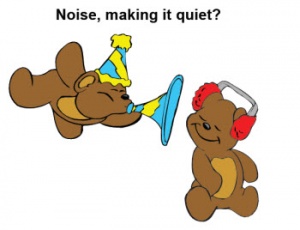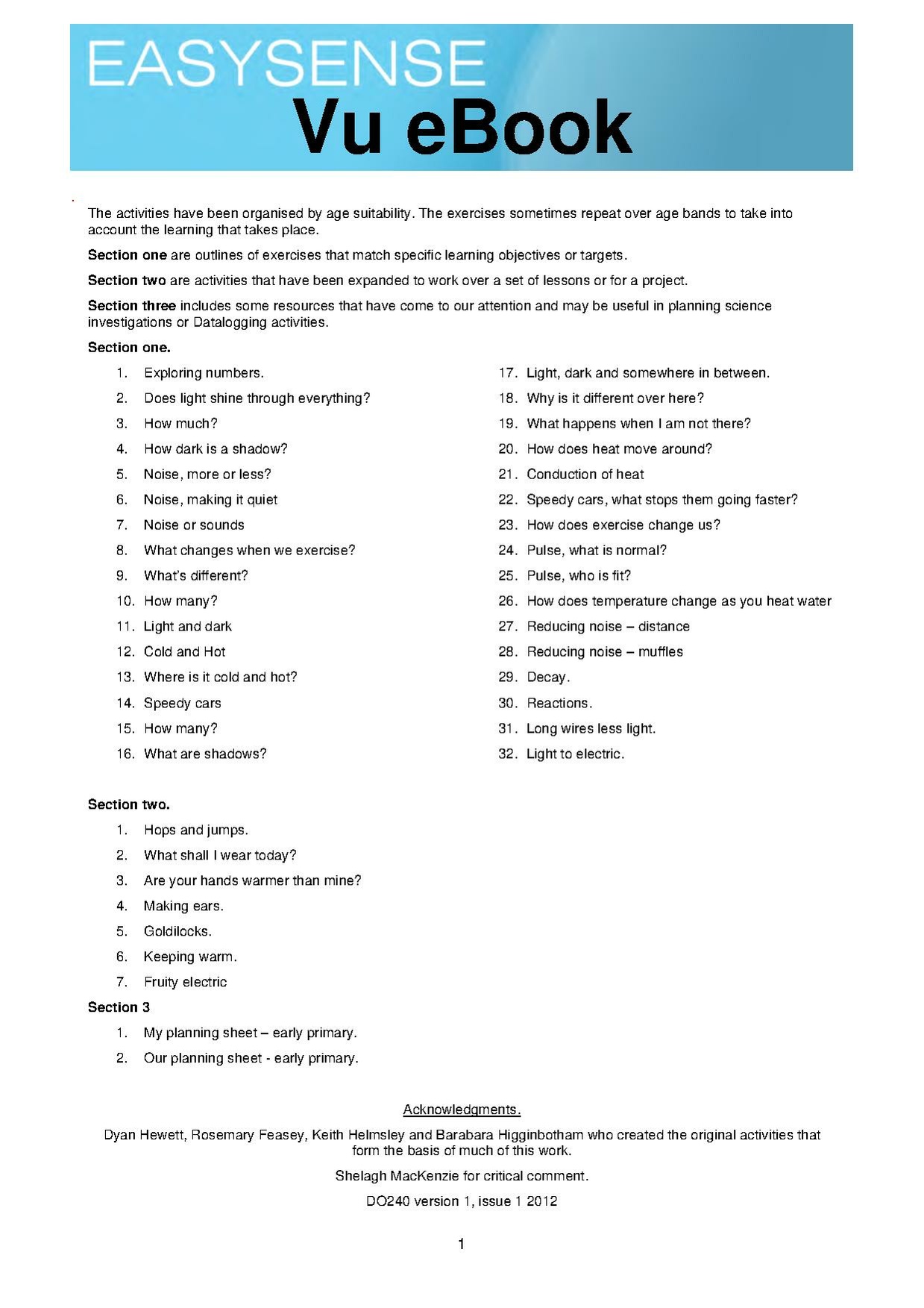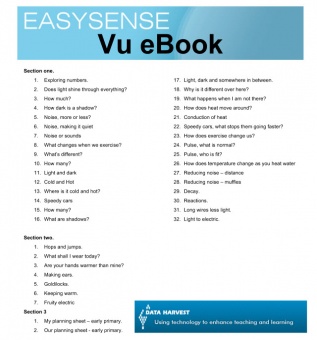Infant and Primary Science Activities with Sensors: Difference between revisions
m (subjects, ages, types) |
No edit summary |
||
| Line 9: | Line 9: | ||
|resourcenumber=SC0057 | |resourcenumber=SC0057 | ||
|age= Primary age 4-11, Primary | |age= Primary age 4-11, Primary | ||
|content=An updated and expanded ideas booklet by UK company ''Data Harvest'' which shows the scope for using sensors in primary science | |content=An updated and expanded ideas booklet by UK company ''Data Harvest'' which shows the scope for using sensors in primary science and introduces more ideas, more teacher guidance and more recent data capture equipment made by Data Harvest. Ideas include comparing bowls of porridge based on the story of Goldilocks and comparing the fabric transparency of curtains. Each activity has a teacher page with learning objectives. | ||
These resources were made for ''Vu'' equipment and software, so you may find detail differences in the instructions. The activities within this booklet might be adapted to work with other brands of sensors and software. The ideas however, ought to mesh well with UK curricula. A snapshot of the content may be seen below. | |||
|strategy= | |strategy= | ||
|tagline=A compendium of investigations with sensors in primary science | |tagline=A compendium of investigations with sensors in primary science. | ||
|Learning Objectives= | |Learning Objectives= | ||
* | * Understanding how sensors display values. | ||
* | * Knowing that temperature, light and sound can be 'measured'. | ||
* | * Understanding broadly what the sensing equipment does. | ||
* | * Learning about various science concepts such as reflection, insulation, transparency. | ||
* | * Seeing ways to take their investigations further. | ||
|additional resources= | |additional resources= | ||
|useful information=The Vu equipment homepage is http://vudatalogger.com/wp/. Published by Data Harvest Group Ltd www.dataharvest.co.uk. Acknowledgements to Barbara Higginbotham (Data Harvest); Dyan Hewett; Keith Hemsley (Learning Connections) Rosemary Feasey. | |useful information=The Vu equipment homepage is http://vudatalogger.com/wp/. Published by Data Harvest Group Ltd www.dataharvest.co.uk. Acknowledgements to Barbara Higginbotham (Data Harvest); Dyan Hewett; Keith Hemsley (Learning Connections) and Rosemary Feasey. | ||
|final=yes | |final=yes | ||
|related resources=[[Primary_Science_Curriculum_Activities_with_Sensors| The first or 'Easy Sense' edition of this booklet: Primary_Science Curriculum_Activities with Sensors]] | |related resources=[[Primary_Science_Curriculum_Activities_with_Sensors| The first or 'Easy Sense' edition of this booklet: Primary_Science Curriculum_Activities with Sensors]] | ||
|other= | |other= | ||
|format=Online booklet - contributed by Data Harvest UK Ltd | |format=Online booklet - contributed by Data Harvest UK Ltd. | ||
|resources= The resource is available as | |resources= The resource is available as | ||
* printable PDF | * a printable PDF - 113 pages [[file:EasySense_Vu_eBook.pdf| ebook to download file:EasySense_Vu_eBook - Infant and Primary Science Activities with Sensors]] | ||
* editable | * an editable Word document - [[file:EasySense Vu eBook.doc| ebook to download file:EasySense_Vu_eBook - Infant and Primary Science Activities with Sensors]] | ||
[[File:EasySense-Vu_ebook_from_Data_Harvest.jpg|border|340x340px| |Preview snapshot from 'Primary Curriculum Activities']] | [[File:EasySense-Vu_ebook_from_Data_Harvest.jpg|border|340x340px| |Preview snapshot from 'Primary Curriculum Activities']] | ||
Revision as of 11:50, 26 November 2012
Lesson idea. An updated and expanded ideas booklet by UK company Data Harvest which shows the scope for using sensors in primary science and introduces more ideas, more teacher guidance and more recent data capture equipment made by Data Harvest. Ideas include comparing bowls of porridge based on the story of Goldilocks and comparing the fabric transparency of curtains. Each activity has a teacher page with learning objectives. These resources were made for Vu equipment and software, so you may find detail differences in the instructions. The activities within this booklet might be adapted to work with other brands of sensors and software. The ideas however, ought to mesh well with UK curricula. A snapshot of the content may be seen below.
Teaching approach. This is a compendium of activities to engage pupils in inquiry(ta) based learning in the scientific method(ta), often making effective use of ICT(i) and sensors(tool). The activities involve whole class(ta) questioning(ta) and collaborative(ta) group work(ta). (edit)
| Resource details | |
| Title | Infant and Primary Science Activities with Sensors |
| Topic | [[Topics/ICT|ICT]] |
| Teaching approach | [[Teaching Approaches/Questioning|Questioning]], [[Teaching Approaches/Whole class|Whole class]], [[Teaching Approaches/Group work|Group work]], [[Teaching Approaches/Inquiry|Inquiry]], [[Teaching Approaches/Collaboration|Collaboration]], [[Teaching Approaches/Scientific method|Scientific method]] |
| Learning Objectives |
|
| Format / structure | Online booklet - contributed by Data Harvest UK Ltd. |
| Subject | [[Resources/Science|Science]] |
| Age of students / grade | [[Resources/Primary age 4-11|Primary age 4-11]], [[Resources/Primary|Primary]]
|
| Useful information | The Vu equipment homepage is http://vudatalogger.com/wp/. Published by Data Harvest Group Ltd www.dataharvest.co.uk. Acknowledgements to Barbara Higginbotham (Data Harvest); Dyan Hewett; Keith Hemsley (Learning Connections) and Rosemary Feasey. |
| Related ORBIT Wiki Resources | |
| Files and resources to view and download | The resource is available as
|



